ROADS IN JAPAN
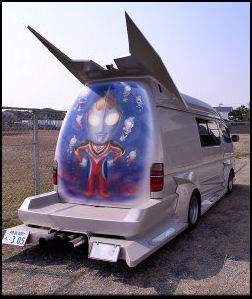
Ultraman Special As of April 2009 Japan had 1,266,770.4 kilometers of roads. Roads are generally first rate in Japan. There is a dense network of state highways and secondary roads enabling motorists to reach all parts of Japan. The roads in Japan are in most cases better than those in the United States. The only problem is that many of them are very narrow.
City roads are often narrow and congested. Bicycles, trucks, cars and buses all have to share the same limited space. Pedestrians are sometimes clipped by vehicles because there are no sidewalks. Japanese cars are often outfit with side views mirrors that retract, allowing vehicles to squeeze through tight spaces. Country roads are often as narrow as bike paths and special mirrors and passing areas are set up at curves to allow cars going in opposite directions to pass one another. In Tokushima Prefecture more than half the road are only wide enough for one car to pass at a time.
Traffic is sometimes a problem, especially during rush hour, weekends and holidays. Some roads are also filled with truck but Japan trucks are generally smaller and less threatening than their American counterparts. Parking and reckless drivers and motorscooters drivers are problems in the cities.
Websites and Resources
Good Websites and Sources: Good Photos at Japan-Photo Archive Auto-Related Stuff japan-photo.de , Bus-Related Stuff japan-photo.de and Filling Stations japan-photo.de ; U.S. Embassy on Driving in Japan tokyo.usembassy.gov ; Getting a Japanese Driver’s License globalcompassion.com/driving ; “Why I Hate Driving in Japan” japantoday.com/category/commentary ; Association for Safe International Road Travel: www.asirt.org Driving FAQs ajet.net/modules/articles ;Japanese Motoring History st.rim.or.jp ;Japan Shuffle, a blog with info on cars japanshuffle.blogspot.com ; Statistical Handbook of Japan Traffic Accidents Section stat.go.jp/english/data/handbook ; 2010 Edition stat.go.jp/english/data/nenkan ; News stat.go.jp ; Bus Travel Website: Learning About Kyoto Kyoto University
Sites for Expats Japanable site for Expats japanable.com ; That’s Japan thats-japan.com ; Orient Expat Japan orientexpat.com/japan-expat ;Kimi Information Center kimiwillbe.com ;Foreign & Commonwealth Office Report on Japan fco.gov.uk/en/travel-and-living-abroad ; Student Guide to Japan www2.jasso.go.jp/study ; Japan in Your Palm japaninyourpalm.com
Links in this Website: BICYCLES AND MOTORCYCLES IN JAPAN Factsanddetails.com/Japan ; URBAN TRANSPORTATION IN JAPAN Factsanddetails.com/Japan ; TRAINS IN JAPAN Factsanddetails.com/Japan ; SHINKANSEN (JAPANESE BULLET TRAINS) Factsanddetails.com/Japan ; AUTOMOBILES AND DRIVING IN JAPAN Factsanddetails.com/Japan ; AUTOMOBILES ACCIDENTS IN JAPAN Factsanddetails.com/Japan ; HYBRIDS, FUEL CELLS AND ELECTRIC CARS IN JAPAN Factsanddetails.com/Japan ; JAPANESE AUTOMOBILE INDUSTRY Factsanddetails.com/Japan ; JAPANESE AUTOMOBILE COMPANIES Factsanddetails.com/Japan ; TOYOTA Factsanddetails.com/Japan ; TOYOTA PRODUCTION AND WORKERS Factsanddetails.com/Japan ; TOYOTA PROBLEMS Factsanddetails.com/Japan ;TOYOTA CARS, RACING AND ROBOTS Factsanddetails.com/Japan ;HONDA Factsanddetails.com/Japan ;HONDA CARS, PLANES, ROBOTS AND RACING Factsanddetails.com/Japan ;NISSAN Factsanddetails.com/Japan ; INFRASTRUCTURE AND PUBLIC WORKS IN JAPAN Factsanddetails.com/Japan
Good Websites and Sources on Transportation: Good Photos at Japan-Photo Archive japan-photo.de and japan-photo.de ; Ministry of Land, Infrastructure, Transport and Tourism mlit.go.jp ; Statistical Handbook of Japan Transport Chapter stat.go.jp/english/data/handbook ; 2010 Edition stat.go.jp/english/data/nenkan ; News stat.go.jp
Expressways in Japan
Japan’s has 8,500 kilometers of expressways. Most of them are toll roads with very high tolls. Expressways, with tall walls that arch over the road and trap sound, wind through crowded urban neighborhoods. In Osaka there are highways that go through buildings and houses built under sections of elevated highway. On holidays and busy weekends the traffic jams on expressways can go on for dozens of kilometers.
Construction of expressways (toll roads) began in the 1960s. The first to be completed was the Meishin Expressway, linking Nagoya to Kobe, in 1965. It was soon linked to Tokyo via the Tomei Expressway. The Kanetsu, Tohoku, Joban, and other long-distance expressways have followed over the past several decades. Tokyo and other major urban areas maintain a comprehensive and ever-expanding network of expressways linking downtown areas to the suburbs. Expressway construction in Japan has faced many challenges: the nature of the terrain, high concentrations of factories and housing, high land prices along the routes, and added reinforcement needed to withstand earthquakes. Construction costs are the world’s highest, and for this reason expressway tolls are proportionately high. Nevertheless, expressways are in extensive use. [Source: Web-Japan, Ministry of Foreign Affairs, Japan]
“During fiscal 2010, the average daily traffic flow between Tokyo and Komaki (near Nagoya in Aichi Prefecture), was 428,000 automobiles. The frequent traffic jams on metropolitan roads are a major problem. In Tokyo, an extensive system of expressways and roads radiates out from the center of the city, but delays in the building of loop lines have contributed to chronic traffic congestion. Traffic safety has been a national issue since the 1960s.
Driving in Japan
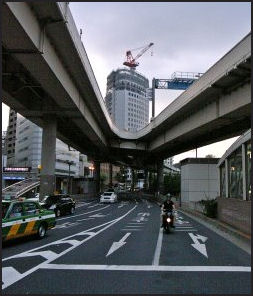
city highway
Driving is on the left side of the road (like Britain), the road signs are sometimes only in Japanese and distances and speeds are measured in kilometers. Gasoline cost about ¥120 per liter (over $4 per gallon) and filling up the tank for a small Honda cost about $50. Tolls are also very high. Tolls for the five-hour round-trip between Tokyo and Mt. Fuji can run as high as $75. Sometimes the tolls for crossing a single bridge can be over $50.
Japanese drivers are generally very good and considerate and the driving laws in Japan are more or less the same as those in the U.S. Many “two-way” roads are so narrow that one has to back up and give way when two cars confront each other. Drivers sometimes run red lights (the time between a yellow light and a green light in the other direction is longer than in the United States, giving a driver a little extra time when the light turns form orange to red).
Japanese often park their cars illegally and block traffic, turning busy two-lane streets into one-land roads and four line highways into two lane roads. According to police there are about 127,000 illegally parked cars in the Tokyo area alone at any given moment. Sometimes the illegally-parked cars are occupied by salarymen who are sleeping or reading pornographic manga comic books.
Stop signs are triangular in shape. In the cities people sometimes dim their lights when pulling into a stop light at night. Traffic from the right has the right of way even when merging from a small side street. In the countryside, slow drivers are expected to pull over to shoulder of the road to let the faster traffic get by.
Parking is a problem.Spaces are hard to find. Parking garages are extremely expensive, sometimes running as high as $10 an hour. Overnight parking violations can result in fines of up to $1,600 and the delivery of a pamphlet that lectures the violator on how rude and selfish illegal parking is. When paying the fines the violator often has to provide a letter of apology.
Rent for reserved parking spaces can cost as much as apartments. Even then cars are often parked two or three to a space on special elevators. Supermarkets and large discount stores have their parking lots on their roofs.
Japanese Drivers

parking exit In 2005, 78.8 million people held driver’s licenses and 79.21 million vehicles were registered.
The driving age in Japan is 18. Drivers test is very difficult. A lot of people fail. There are three parts: a written test, inside driving on a simulator and an outside driving test. A person has to past one test to move on to the next. My wife failed the test three times before she passed.
Driving in Japan is an expensive proposition. The costs for cars, gasoline are parking are all very high. Yearly inspection fees often exceed $1,000 and can run as high as $2,000. Driving lessons can cost between $2,000 and $6,000. Some people get a license to use it as an I.D. but never drive and find spending $600 a month on taxis to be easier and more cost effective than owning a car. A “paper driver” refers to someone with a license that doesn’t actually drive
In Japan, it is perfectly fine for a man to drive in the front seat while his wife sits in the back seat with her kids or even by herself. In Tokyo there are laws that require backseat passengers to wear seatbelts.
There has been a campaign to get motorists to turn off their engines at traffic lights to save energy and reduce pollution. Taxis that support the campaign have a “Idling STOP” bumper sticker.
Driving Laws in Japan
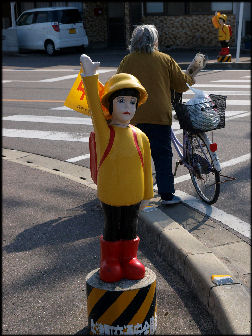
road crossing People who get three tickets in three years lose their license for a month and are required to attend a 3½-hour safety lecture complete with lectures on drunk driving and videos of gory accidents and must do public service such as picking up litter or manning an elementary school crosswalk.
Using a cell phone while driving is an offense in Japan. In some places motorists who are caught talking on their cell phone while driving can be fined $200.
Beginning in 2008, drivers over 75 were required to put a symbol on their car that showed others that an elderly driver was behind the wheel. In some areas elderly drivers over 65 are being given coupons at hotels and department stores and discounts on public transportation to encourage them to give up their driving license. The government is trying to get elderly driver off the road. In 2007, drivers over 65 accounted for 47.5 percent of traffic accident deaths and were recognized as the cause of 102,961 traffic accidents, 3,108 more than in the previous year and twice as many as in 1997.
See Drunk Driving Below
High Tolls in Japan
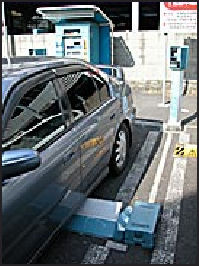
parking space
vending machine Expressway tolls are very high in Japan. As a result many people don’t use the expressways unless they absolutely have to. If one driven from Kobe on the Chugoku Expressway in western Honshu and the Kyushu Expressway to Kagoshima — a distance roughly equal to driving from Boston to Washington D.C. — the toll is $168.
In March 2009, expressway tolls were reduced on weekends and holidays to to a maximum of 1,000 yen ($10) on weekends and holidays, meaning that $168 toll described above was be reduced to $10. Standard size and small cars equipped with an electronic toll collection (ETC) device, which allows drivers to pay with a credit card without stopping at toll gates, qualified for the discount. The DPJ government elected in August 2009 has promised to crap expressway tolls , possibly in 2012.
Tolls will be dropped in a limited number of expressways on a trial basis beginning in June 2010. The plan applies to about 20 percent of Japan’s 8,500 kilometers of expressways. Many of the expressways are lightly used and the section that are toll-free relatively short, making it difficult to travel a long distance without paying tolls.
In the first major holiday after the new toll rules were enacted — Golden Week in May 2009 — huge traffic jams were created as expressway traffic surged more than 20 percent. Expressway authorities reported 58 traffic jams that stretched for more than 30 kilometers. One traffic jam in the Kobe area stretched for 68 kilometers. Sales at expressway rest stops boomed. Japan Railways reported a 7 percent drop in passengers.
In June 2010, drivers were able to drive on 20 percent of the nations expressways — 1,652 kilometers on 50 sections of 37 routes — for free
In April 2011, the government decided to scrap the ¥1,000 limit on expressway tolls on national holidays to secure funds for relief efforts after the earthquake and tsunami in March 2011 although it decided to keep in place the 50 percent discounts on expressway tolls on national holidays. The plan to introduce a cap of ¥2,000 on weekdays was also scrapped. The ending of the toll discounts went into effect in mid-June 2011.
In December 2010, the government proposed doubling the maximum highway toll for a one-way journey to ¥2,000 but suggested simplifying the system so that the maximum toll would be in effect every day of the week rather than just on weekends. Another idea proposed was capping the weekday tolls at ¥2,000. Under a system that ended on March 2011, the maximum highway toll for a one-way journey was ¥1,000 for journeys on weekends and holidays.
The tolls are very high for some bridges and tunnels too. The toll on the Aqua-Line bridge-tunnel between Tokyo and Chiba was initially ¥4,000 one-way for a standard-size vehicle but was lowered to ¥3,000 in 2000. Taking the Aqualine route to Narita airport from Kawasaki cost twice as much as the Bayshore route and Higashi-Kanto Expressway.
Navigation Systems in Japan
Navigation systems, using GPS satellite technology, are fairly common in Japanese automobiles. They show the car's location on a detailed map, provide information on reaching a destination, give detailed information on traffic, and suggest alternative routes. When the navigation system is not being used the screen becomes a television. Some systems show empty parking spaces and provide information on what movies are playing.
A total of 4.07 million car navigation systems were sold in 2006, up from 1.5 million units in 2000 and 800,000 in 1997. Many new cars have them as standard equipment.
Some people in quiet neighborhoods complain that the navigation systems have created a danger by advising cars — avoiding traffic jams and looking for shortcuts — to go through the quiet streets where their children play.
The Nagoya government is experimenting with a system using cell phones, digital and GPS devices in taxis and buses to solve traffic problems. The basic ideas is that communications devices in vehicles will alert computers of traffic problems and send messages to cars or cell phones to give people warning or suggests alternative routes.
Parking and Traffic in Japan
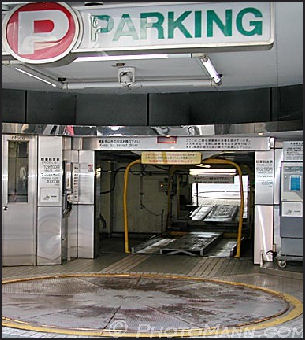
parking lot vending machines To register a car in Japan you need to prove you have a place to park. Often police come to a person's house to measure the space to make sure the car fits. Anyone found having a car with no space faces up to three years a jail.
Cars are parked in parking lots on the roofs of buildings. Occasionally someone makes a mistake, stepping on the accelerator rather than the brake, and breaks through a barrier and crashes five or six stories to their death. Many apartments have elevators for cars that lift one car up, allowing another to be parked underneath it.
Illegal parking is a big problem, especially in the Osaka area. Four lane roads often effectively become two-lane roads because so many people are parked along the sides. People also park on sidewalks. In some cases people line up for illegal spots the same way they do for legal ones.
Sometimes police make chalk marks next to car that are illegally and if they return and find the car is still there the write a ticket. During crackdowns on illegal parking private parking wardens take a photograph of illegally parked cars and record the licence plate in a book. During these drives people avoid illegal parking zones and park there again when the crackdown ends.
Chronic congestion in Tokyo alone cost the economy an estimated ¥10 trillion yean a year. During the peak of the August summer vacation season in 2001 a traffic back up of 30 miles was reported in the Chuo Expressway from the Uenohara interchange in Tokyo to Yamanshima prefecture. At the same time were traffic jams of 21 miles and 25 miles in other parts of the Tokyo area.
In January 2011, during the New Year holiday, a road in Tottori was closed for 42 hours after 1,000 vehicles became trapped in the snow. About a month later 950 vehicles were stranded in an expressway and national road in Fukui Prefecture because of heavy snow. Many travelers had to spend the night in their vehicles after a cold weather system dumped 86 centimeters of snow.
Japanese often call green traffic lights blue. Intersections have crossing signals that tell pedestrians in polite high female voice that it is safe to cross the street.
Image Sources: Ray Kinnane except parking machines (Doug Mann Photomann) and Smart Car (exorsyst blog)
Text Sources: New York Times, Washington Post, Los Angeles Times, Daily Yomiuri, Times of London, Japan National Tourist Organization (JNTO), National Geographic, The New Yorker, Time, Newsweek, Reuters, AP, Lonely Planet Guides, Compton’s Encyclopedia and various books and other publications.
Last updated August 2012
